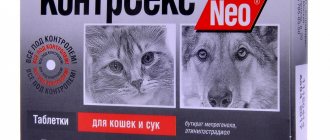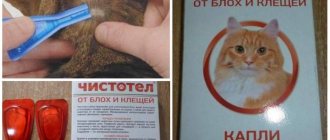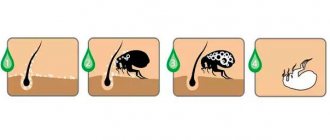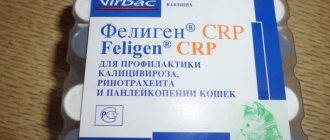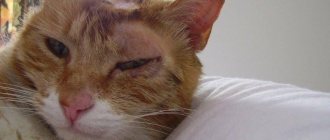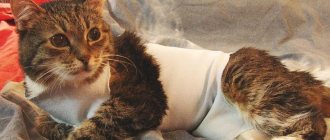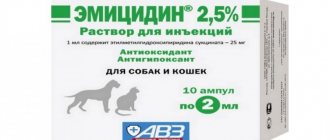- Myths and legends about ASD 2
- Before using ASD 2
- Methods of using ASD 2
- Dosage of ASD 2 for cats
Antiseptic Dorogov stimulant (ASD) is used to treat various diseases in animals and humans. The only difference is in the treatment methods and dosage of the drug. For treatment, ASD fraction 2 and ASD fraction 3 are used. ASD fraction 2 is a liquid, it is used internally or externally. ASD fraction 3 is an ointment, it is used only externally. The description of the drug and its production are shrouded in mystical phenomena in which witches participate, “closed clinics” for party and government officials of the USSR, legends about how people stood for days to get a bottle of ASD. They also write about the suffering caused by the stinking smell of the drug and about miraculous healing from any disease. All this fuels interest in ASD, at the same time, disappointment from the use of ASD. Such an attitude towards SDA is not deserved for him. Therefore, I will start by debunking myths and legends about ASD.
Instructions for use of ASD fraction 2 for cats
ASD-2 (Dorogov's antiseptic stimulant) is a broad-spectrum drug that was invented by a Soviet scientist in 1947. The instructions for ASD-2 fraction for cats will help you calculate the course and determine the dose for your pet. The drug improves digestion, has a beneficial effect on the immune system, and increases the body's protective functions. ASD-2 is used to treat large and small cattle, dogs, cats and other animals. Initially, the fraction was developed for the treatment of oncological diseases in veterinary medicine.
How did the drug ASD-2 appear?
The name “ASD-2” is an abbreviation that stands for “antiseptic Dorogov stimulant.” The drug was developed in 1948 by Soviet veterinarian Alexei Vlasovich Dorogov, who at that time worked at the All-Union Institute of Experimental Veterinary Medicine (VIEV).
Andrei Vlasovich, inspired by the works of surgeon and ophthalmologist Vladimir Petrovich Filatov on the use of tissue therapy, exposed meat and bone raw materials to high temperatures without air access, and then collected the resulting breakdown product by condensation at low temperatures. The result was a dark liquid - it was called fraction 1. After settling, it was divided into two fractions: 2 and 3. Actually, ASD-2 is the second fraction.
Dorogov decided to test his drug on animals and discovered that it helps stimulate biological processes in the body and fight pathogenic factors. Later, the country's leadership became interested in this development, and tests of the drug were carried out on animals and even humans. Not all of them ended in success: in some cases, the remedy actually helped speed up recovery, in other cases it improved the condition, but did not help cope with the disease, and in others it was simply useless.
It is often said that Dorogov was not allowed to complete his work, that he had many enemies among eminent doctors who did not want to cure people from terrible diseases. In fact, the drug's trials have been largely completed. The reason for the scientist’s dismissal was conflicts with management—there was no “conspiracy against a brilliant invention” here. In the 50s, ASD was at the peak of its popularity, and decades later, interest in it cooled down, its production gradually began to wind down. They forgot about him for a long time, but now he is again on the lips of many, mainly thanks to the efforts of representatives of alternative medicine.
It cannot be denied that Alexey Vlasovich Dorogov was a talented scientist; he made a great contribution to the development of domestic veterinary medicine. But ASD-2 is not a panacea, and its ability to cure cancer has not been proven in any scientific study.
Release form and composition of ASD-2 for cats
The drug is of animal origin and is a product of processing meat and bone waste, meat and bone meal. Additionally, it contains: water, compounds with a sulfhydryl group, carboxylic and cyclic acids, derivatives of aliphatic amines. The substances in the fraction affect the body at the cellular level. The drug is a sterile solution with a pungent and unpleasant odor. The color of the medicine can vary from yellowish to deep red. The ASD fraction is sold in glass bottles of various sizes from 10 to 200 ml.
Composition and release form of the drug
ASD-2 fraction is a natural-based medicine, the active components of which are synthesized through thermal processes of decomposition of animal tissues.
The drug Asd-2 is a medicine with a wide spectrum of action.
The resulting product has a specific odor and is a volatile composition, the color of which can vary from yellowish to deep red.
The liquid is mixed with water and packaged in glass bottles of 20 and 100 ml. A small amount of sediment may be present.
Directions for use and dosage
The dosage and regimen of the drug depend on the purpose for which the antiseptic stimulant is used for cats. For preventive purposes, 1 drop per 5 kg of cat’s body weight is recommended. For therapeutic and prophylactic use – 3-4 drops per 5 kilograms of weight. Do not exceed the dose by more than 2 drops per kilogram of animal body weight.
According to the annotation, the drug dissolved in water or milk is given to the cat once, in the morning. The course of treatment is 5 days, after which a break is taken for 2-3 days. Once the result is achieved, treatment is stopped.
The dosage for the treatment of tumors is prescribed by a veterinarian in accordance with the age and individual characteristics of the cat.
The approximate maximum dose for a cat is 5 drops per day. The ASD fraction is active in the body for up to 4 hours. Accordingly, the drug can be given up to 4 times a day with an interval of 4 hours.
If the condition worsens, you must immediately stop using the drug and show the cat to a specialist!
Treatment regimens and therapeutic doses
The treatment regimen, as well as the dose and duration, is selected taking into account the individual characteristics of the body and pathology.
To prevent diseases in cats and kittens, it is recommended to use one drop of the drug per 5 kg of body weight.
For the treatment of various pathologies, 3-4 drops of the drug ASD-2F are prescribed per 5 kg of weight. The drug is administered orally with drinking water. It is preferable to give ASD-2 to kittens before feeding, in the morning. Mixing with food is allowed.
If the cat does not want to drink the drug, and many cats do not like this, you will have to force feed it from a syringe without a needle, pouring the medicine into the cheek and pressing the jaws tightly with your hand. Stimulate swallowing by stroking along the esophagus.
Some animals do not refuse to take ASD if you mix it with their favorite treat: minced meat, milk, sour cream.
- For the treatment of skin pathologies (eczema, dermatitis, lichen), the use of lotions with a 2-20% solution of the elixir is prescribed. To prepare the solution, use boiled, cooled water or saline solution. A napkin soaked in the product is applied to the affected area once a day. The duration of treatment is until complete recovery.
- In the fight against dyspepsia, gastritis and dystrophic conditions, the drug is given to cats once a day in five-day courses. If necessary, treatment is repeated after a three-day break.
- For infected wounds and fistulas, it is recommended to wash the affected areas with a 20% solution of an antiseptic stimulant.
The medicine has been used in veterinary practice for many years. It has managed to earn trust. And this is not surprising, because this universal drug cures almost all diseases of cats.
In addition to ASD-2, the drug ASD-3 fraction, which is used externally, is also widely used. The main thing is to prevent the cat from licking the medicine, because it is toxic even in diluted form.
The main thing is to follow the dosage of the composition and under no circumstances interrupt treatment.
Special instructions and precautions when working with ASD-2
It is necessary to work with the ASD-2 fraction carefully, observing safety precautions and personal hygiene. After the procedure, be sure to wash your hands with soap. It is prohibited to eat food during contact with the drug, as well as use it in close proximity to food.
When interacting with air, the liquid changes its properties. Therefore, when using the drug ASD-2, you must act according to the instructions :
- remove the middle part of the upper metal cap;
- shake the bottle with the drug vigorously several times;
- insert a sterile syringe through the rubber cap;
- turn the bottle over and take the required dose of the drug;
- during collection, the bottle must be held upside down;
- carefully remove the syringe;
- Without removing the needle, lower the syringe into a container with water (milk);
- gently squeeze the solution into the liquid;
- Stir the contents a little.
Side effects and contraindications
Experience has shown that with long-term use of ASD-2, in rare cases, an increase in blood density is possible. Therefore, monitoring the progress of treatment is necessary. Especially for older cats.
Despite the fact that no contraindications or side effects were found when treating with the ASD-2 stimulant in accordance with the instructions, cats, like people, may experience individual intolerance to the drug.
During the course of treatment, you must ensure that the cat drinks water. The more liquid an animal consumes, the faster its body will cleanse itself of toxins. .
Despite the fact that ASD-2 has a wide spectrum of action and has no contraindications, it should not be used for the prevention and treatment of diseases without consulting a veterinarian. Self-medication of a cat can be dangerous to the life and health of the animal.
Limitations and side effects
As a result of using the ASD-2 fraction for cats, there are no side effects. And also the medicine does not pose a danger to humans and other animals.
However, the following precautions should be observed when using it:
- Store an opened bottle for no more than 14 days.
- When working with the medicine, use rubber gloves.
- Dispose of empty containers with household waste.
Attention! Despite the fact that the medicine does not contain chemicals or potentially hazardous substances, it is strictly prohibited to use empty bottles for household needs.
How to treat cats with ASD-2 fraction
ASD is an antiseptic stimulant, named after the scientist who synthesized it, A.V. Dorogova. The product contains a fairly large amount of organic and mineral substances, which contribute to the rapid restoration of the body and its cure from a number of diseases, including cancer.
ASD is obtained from meat and bone meal, and as a result, 2 fractions are isolated: water-soluble ASD-2 and fat-soluble ASD-3. Both remedies are used in the treatment of domestic animals, including cats. Successful tests of the drug ASD on animals took place back in the 1950s.
Dosage of ASD 2 for cats
From publications on the use of ASD 2 in the treatment of disease in humans, it follows that when the dosage of ASD 2 exceeds 120 drops per day, the drug becomes ineffective, otherwise, when taking 120 drops or 150 drops per day, the result will be the same. Based on the human/cat weight ratio, the maximum effectiveness and approximate dosage for a cat is 5 drops per day. At the same time, I note that the dosage is individual for each cat and has no restrictions from above. You can give your cat more than five drops per day if your pet's health improves. At the same time, there is no need to abuse increasing the dosage. In any case, this will be an extra burden on the liver. Perhaps one drop of ASD 2 per day will be enough for your pet, it all depends on the severity of the cat’s disease and is determined by the cat’s well-being. The drug can be given once a day (in the morning), twice a day (morning and evening), and so on up to four times a day with an interval of at least four hours. What should you pay attention to when preparing a solution of ASD 2 in milk (water). It is necessary that the solution be in contact with air for as little time as possible during mixing and that the ratio of one part ASD 2 to 20 parts milk be maintained.
It is recommended to give your cat ASD 2 starting with one drop per day. The next day you repeat everything with the difference that in one milliliter of milk there will be two drops of ASD 2. So every day increase the number of drops and quantities of milk, maintaining a ratio of no more than two drops of ASD 2 per milliliter of milk. Having reached five drops per day, start counting them in reverse order. At the end of the course, evaluate your pet’s well-being. If it’s no worse than before the start of the course, then that’s good. If the effect was obtained, then first of all you will notice an increase in your pet’s appetite, he will become more sociable and more cheerful. A day (two) after finishing the course you can repeat it.
However, the dosage of ASD 2 for cats is not the main problem; how to feed ASD 2 to a cat is the main problem. Only two drops of ASD 2 can be dissolved in one milliliter. A cat cannot swallow more than one milliliter at a time. Or it may happen that half a milliliter of liquid will be the limit for your cat, in which case you can give your cat ASD 2 in a dosage of one drop. If the dosage of ASD 2 requires a volume of liquid greater than your cat can swallow at one time, then the daily dose can be divided into several parts and fed to the cat throughout the day, but not more often than after four hours.
Below I will give an example of a one-time dose of ASD 2 at the maximum dosage, 5 drops. I’ll start by preparing for the “ceremony” of feeding ASD 2. Remembering that ASD 2 is supposedly toxic to cats, we will dissolve ASD 2 in milk - the fattier the better. For five drops of ASD 2, you will need 2.5 milliliters of milk, which you must give to the cat in three doses, two times one milliliter and one time 0.5 milliliters. Most likely you won’t be able to do this, then you can use the next option. Dissolve all five drops of ASD 2 in one milliliter of milk and place this solution in one syringe. In the second syringe, draw about two milliliters of pure milk, without ASD 2. First, give the cat milk with ASD 2, do it quickly, then feed the cat pure milk from the second syringe. With this option, you cannot use water instead of milk, as this can cause a burn to the cat’s digestive tract mucosa. For a one-time dose of ASD 2 in a dosage of 5 drops you will need; - the drug itself in a glass bottle (not plastic), - three disposable syringes with a capacity of 2 milliliters (2 cubes), - a tablespoon, - milk or cream. First, pour a little milk into a tablespoon. If the milk is cold, then before pouring the milk, the spoon needs to be warmed up. They poured the milk and placed the spoon on the table so that the milk did not spill out of the spoon. We take the first syringe and mark it somehow. Remove the needle and draw one milliliter of milk into the syringe from a spoon. In the second syringe, draw 1.5-2 milliliters of milk from a spoon. We put the syringes with milk aside, pour the remaining milk from the spoon. We take the third syringe and proceed to withdraw ASD 2 from the bottle; how to do this is written above. We will need very little solution, about two small divisions of the syringe (about three drops in one division of the syringe). Having drawn ASD 2 from the bottle into the syringe, disconnect the syringe from the needle and drop five drops from the syringe into an empty spoon. We put the syringe with the remains of ASD 2 aside, wash our hands (optional) so that the smell of ASD does not transfer to the syringes with milk. Then, take the first syringe with milk, which contains one milliliter of milk, and carefully pour the milk into the spoon with ASD 2. Using the tip of the syringe, mix the milk and take it from the spoon back into the syringe. Thus, we have a syringe with milk in which five drops of ASD 2 are dissolved and a syringe with pure milk. We go to the pet to feed the prepared dish. When you give milk from a syringe, the cat will back away, so sit on the floor on your knees, with the cat's tail facing you between your knees. Both syringes are in front of you. First, take a syringe with milk, which contains ASD -2, and insert it into the cat’s mouth from the front teeth so that the tip of the syringe points to the root of the tongue. Squeeze out the milk with a sharp movement. Then take a second syringe and, more slowly than the first time, feed the milk from it to the cat. You can first practice using syringes with water.
The remains of ASD-2 in the syringe can be used for a compress, if there is a need for it. In this case, ASD 2 is diluted with water in a ratio of one to five parts of water. If there is no need for a compress, then drain the remaining ASD 2 from the syringe; it will no longer be useful. Rinse all three syringes in water. Store milk syringes separately from the ASD 2 collection syringe.
ASD is an antiseptic stimulant, named after the scientist who synthesized it, A.V. Dorogova. The product contains a fairly large amount of organic and mineral substances, which contribute to the rapid restoration of the body and its cure from a number of diseases, including cancer.
ASD is obtained from meat and bone meal, and as a result, 2 fractions are isolated: water-soluble ASD-2 and fat-soluble ASD-3. Both remedies are used in the treatment of domestic animals, including cats. Successful tests of the drug ASD on animals took place back in the 1950s.
Indications for use
The drug ASD-2 is a mixture of biologically active substances dissolved in water, and in the case of ASD-3, the solvent is oil. ASD-2 is used for internal use in the treatment of such diseases.
- gastroenteritis;
- dyspepsia;
- dystrophic conditions;
- digestive disorders;
- vaginitis;
- trichomoniasis;
- respiratory diseases;
- oncological pathologies;
- adverse consequences of surgery, infectious disease.
The drug ASD-3 is used externally to treat the following disorders:
- wounds (especially those that do not heal for a long time);
- pustules;
- skin inflammation;
- trophic ulcers;
- dermatitis and eczema of various origins.
It is important to understand that both ASD-2 and ASD-3 are only an aid. In most cases, they are taken together with other medications (with an interval of at least 3-4 hours). Therefore, if the veterinarian has already prescribed a specific course of treatment, you should not neglect it.
Instructions and dosage ASD-2
Since the biological substances that make up ASD-2 are well absorbed only with a sufficient amount of water, before starting therapy you need to make sure that the cat is not suffering from dehydration. If she drinks and urinates as usual, then treatment can begin.
When calculating the dosage, they are usually based on the weight and age of the animal. Use 1 drop per 2 kg of live weight. Therefore, an adult cat weighing, for example, 4 kg can be given 2-3 drops at a time (dissolved in a tablespoon of milk). In this case, the maximum dosage, regardless of the age and weight of the animal, is 5 drops. Frequency – from 1 to 4 times a day. Usually the remedy is given in the morning and evening, in some cases up to 3-4 times (the minimum period of time between doses is 4 hours).
The kitten should be given the minimum dose – i.e. literally the volume of the medicine should be less than 1 drop. The duration of the course also varies. The standard option is to take the drug for 5-7 days, after which a break is taken for 2 days. Therapy is then continued until stable results are achieved.
The liquid is collected using a syringe, since the medicine has a sharp, specific odor. It is unpleasant for both people and animals. The sequence of actions is as follows:
- First you need to remove the aluminum cap.
- Then insert the syringe into the rubber stopper and take out the required volume (based on 1 ml - 35 drops).
- Next, remove the needle and dip it in or into milk (a tablespoon) and quickly feed it to the cat. To do this, the syringe hole is directed directly to the root of the tongue. The liquid is squeezed out with a sharp movement.
- After this, you can quickly pour in a little pure milk, which must be drawn from another syringe (volume 10-15 ml). The milk should be as fat as possible, at room temperature or slightly higher (it can be warmed up a little just before drinking).
Instructions for use fraction
Biologically active substances ASD-2 are well absorbed only with normal fluid levels in the cat’s body. Therefore, make sure that your furbaby does not suffer from dehydration, but goes to the toilet well and drinks enough water. Only after this will it be possible to begin treatment.
Detailed instructions:
- To begin, remove the aluminum protective cap on the fraction bottle.
- Poke the rubber stopper with the syringe needle and draw out the required amount of ASD-2 medication.
- Pour warm milk into a tablespoon, and then put it into a syringe for the medicine.
- Shake the syringe several times, then carefully remove the needle from the syringe.
- Ask someone close to you to hold your pet.
- With one hand, open the cat's mouth, and with the other hand, inject the fraction into the mouth. Try to get it on the roof of your mouth, then the medicine will definitely get into the esophagus.
Sometimes ASD-2 is used to heal wounds, pustules and various inflammations. To do this, gauze is soaked in a small amount of the drug, and then it is applied to the injured area of skin.
How to give the suspension
Instructions and dosage ASD-3
The drug ASD-3 is used only externally in the form of compresses and tampons. The product is taken out with a syringe and diluted with any vegetable oils (the amount of oil is 4 times more than the medicine). The sequence of actions is as follows:
- Take sterile gauze.
- Select the required volume of ASD-3 (4-5 drops).
- Pour onto cheesecloth.
- Mix with oil (16-20 drops).
- Place on the affected area.
- Secure with a bandage.
The dressing is changed once a day or as needed. It is important to ensure that it lies firmly on the surface and does not move to the side.
If there is heavy contamination, the affected area is first cleaned of pus. To do this, use a cotton swab, which can also be moistened in a mixture of ASD-3 and vegetable oil.
Answers to common questions
Question No. 1. Are there any contraindications to the use of ASD-2 and ASD-3 for cats?
There are no specific contraindications. In most cases, no side effects are observed. If unusual symptoms appear, you should stop treatment and consult a veterinarian.
Question No. 2. How to store the drug?
At room temperature (10-30 o C), in a dark place, away from food and medications, out of the reach of children and pets. Once opened, it is advisable to use within 14 days. The general shelf life is 4 years from the date of manufacture.
Question No. 3. Where can I buy the product?
In pet stores and veterinary pharmacies. Also, ASD-2 and ASD-3 are sold on the websites of pharmacy chains.
The cost of the ASD-2 medicine is about 350-370 rubles per 100 ml package. A similar capacity ASD-3 costs about 50-60 rubles.
Reviews on the use of ASD for cats
On the Internet you can find reviews about the use of ASD for both cats and dogs, other animals and even humans. Mostly, pet owners give high marks to this drug - at least 4 out of 5 points. They note that the remedy acts very quickly - sometimes one week is enough for the first signs of improvement to appear.
“Cats have almost the same diseases as people. My Nyusha is 11.5 years old - she is no longer a girl. She never gave birth and was never sterilized. And recently I discovered lumps on her nipples. I took it to the veterinarian and did not self-medicate. They made a terrible diagnosis: inoperable breast cancer. I started giving ASD-2 according to this scheme: first, 1 drop in 5 ml of water, and then increased it by 1 drop every day, as a result it reached 20. Then a break for a month. And she repeated the same thing again. And here is the result: one lump decreased, the others remained unchanged. Nyusha became more active and cheerful. Now I want to teach the third course!”
Elena, 36 years old, Samara
“My cat has a very difficult situation - she was diagnosed with nasopharyngeal cancer or lymphoblastic lymphosarcoma. I started using ASD strictly according to the scheme: I gave 5 drops in a tablespoon of milk. With a sharp movement, she instilled the medicine and immediately gave her full-fat milk - she especially took country milk from the market. After 2 weeks, the swelling almost disappeared, my nose stopped running, and my appetite even improved. I’m delighted – as long as we continue to heal”
Anna, 29 years old, Tula
ASD 2 for a cat
If your pet is sick, ASD 2 for cats is often prescribed. The drug has a rich composition and improves metabolic and digestive processes, prevents the progression of inflammatory processes. The owner of the animal should know the mechanism of action of the drug, indications and contraindications, and also take into account possible side effects.
Veterinarians classify ASD 2 fraction for cats as hazard class 3 (moderately toxic), which means there is no negative effect on the animal’s liver and immune system.
What is treated with ASD-2?
The drug ASD-2 cannot be found in any pharmacological reference book. It appears only in veterinary reference books. It is used in animals to treat diseases of the gastrointestinal tract, respiratory system, skin, genitourinary system, metabolic disorders, and to stimulate the nervous and immune systems. The drug is also used to increase the egg production of chickens and accelerate the growth of chickens and piglets. When listing diseases, we usually talk about infections and inflammatory processes, and digestive disorders. There is not a word about cancer.
Everything that concerns animals cannot be automatically transferred to people. Otherwise, all new drugs would be tested only on mice, and then immediately sent to hospitals. But in reality, the effect of drugs on animals and humans differs, therefore, after laboratory experiments, several phases of clinical trials are always carried out.
What does the drug contain?
Dorogov's antiseptic stimulant for cats is a liquid with a specific pungent odor of a brownish-yellowish tint and contains the following components:
- meat and bone meal products;
- choline;
- peptides;
- choline esters of carboxylic acids;
- amines, amides and ammonium salts;
- compounds with a sulfhydryl (thiol) group;
- nitrogenous compounds;
- purified water.
Return to contents
Mechanism of action
The drug ASD 2 fraction for cats can be used externally and internally. When taken orally, the medicine has the following therapeutic effect:
- improves motility of the digestive organs;
- has a positive effect on the autonomic and central nervous system;
- stimulates the secretion of gastrointestinal glands;
- promotes the absorption of nutrients;
- improves the activity of tissue enzymes;
- stimulates the transport of ions and nutritional components across cell membranes;
- improves protein synthesis;
- promotes nutrition of skin tissue;
- increases immunity;
- normalizes metabolic processes.
When applied externally, ASD 2 fractions have the following therapeutic effect:
- eliminates pathogenic microflora;
- relieves inflammation;
- activates tissue macrophages;
- accelerates the regeneration process.
Return to contents
Indications: when is the drug prescribed?
Veterinarians prescribe ASD 2 fraction for cats for the following disorders:
- lichen;
- weakened immune system;
- suffered severe infectious diseases;
- dysfunction of the central nervous system and autonomic nervous system;
- dermatitis of various etiologies;
- intoxication due to poisoning;
- inflammatory processes of the genitourinary system;
- nasopharyngeal diseases;
- any stage of cancer and metastasis;
- metabolic disorder;
- gastroenteritis;
- endometritis, especially with heavy vaginal discharge.
Return to contents
In what cases is it prescribed
For cats, the ASD-2 fraction is usually prescribed in the following cases:
- Weakened immune system.
- Lichen.
- Dermatitis of various forms.
- Endometritis.
- Severe infectious diseases.
- Any stage of cancer.
- Gastroenteritis.
- Injury to the skin.
- Intoxication of the body due to poisoning.
- Pathologies of the nasopharynx.
- Metabolic disorder.
- Inflammation of the kidneys and genitourinary system.
- Malfunctions of the central nervous system.
- Abscesses.
Dermatitis
Application: how to give the medicine correctly?
The drug is prescribed to kittens with caution due to their low weight, so only a veterinarian should calculate the dosage.
It is important to adhere to the correct dosage of the drug relative to the pet’s weight.
The veterinarian prescribes ASD 2 fraction individually, based on the condition of the animal, the etiology of the disease, and body weight. The dose of the medication should not exceed the proportion of 2 drops/1 kg of weight. The instructions contain the following recommendations:
- prevention - 1 drop/5 kg of weight;
- therapy - 3-4 drops/5 kg.
The medication is given to the cat in the morning for 5 days with a break of 2 or 3 days. For cancer, the dose begins with 1 drop, increasing daily to 20 drops, and then taking the medicine in the reverse order - from 20 to 1 drop. Against lichen, it is recommended to moisten a cotton pad in the preparation and apply it to the problem area. And also for lichen, you can use ASD 3 fraction, which is intended for external use only.
Instructions for use and dosage for cats
The dosage and regimen of use of the drug is prescribed in accordance with the individual characteristics of the animal and its disease.
Instructions for use of the drug for cats contain the following recommendations:
- When used for preventive purposes, the animal should be given one drop per 5 kg of weight.
- In the process of treating diseases, the dose is 3 to 4 drops per 5 kg of cat weight.
- The volume of the drug should not exceed 2 drops per 1 kg of individual weight.
If the animal’s condition worsens or other negative signs appear, you should immediately stop using the drug and consult a veterinarian.


